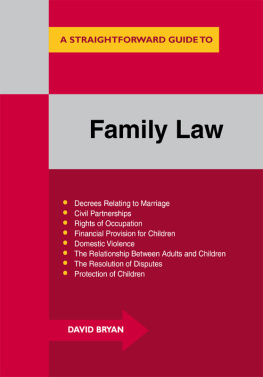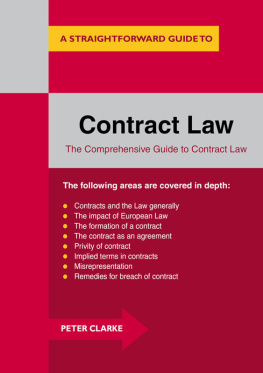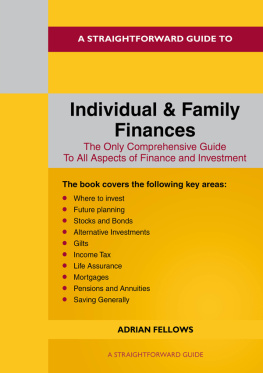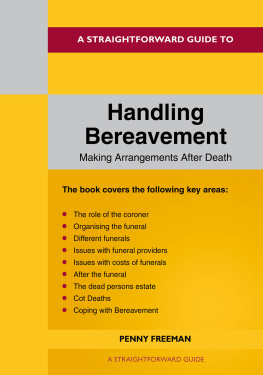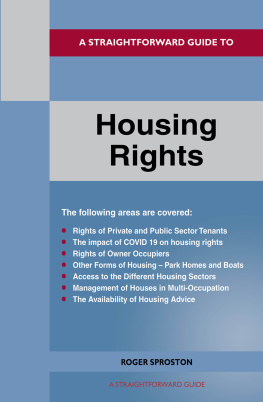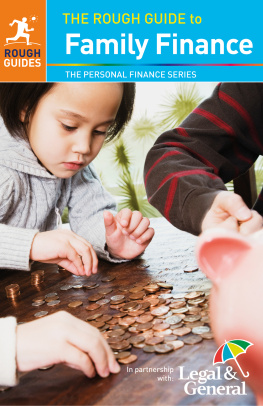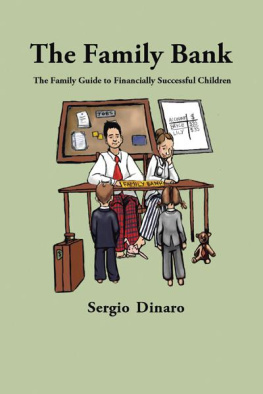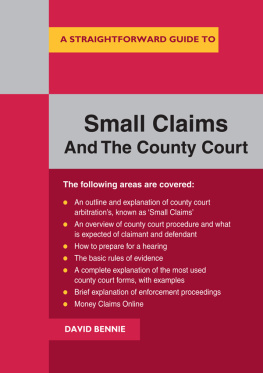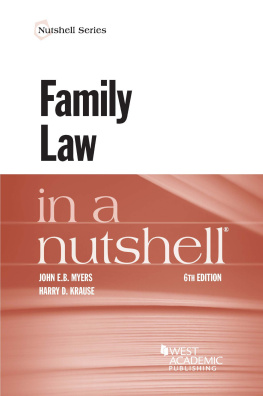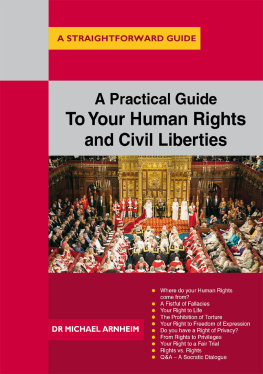A STRAIGHTFORWARD GUIDE
TO
FAMILY LAW
DAVID BRYAN
Straightforward Guides
www.straightforwardco.co.uk
Straightforward Guides
Straightforward Publishing 2015
All rights reserved. No part of this publication may be reproduced in a retrieval system or transmitted by any means, electronic or mechanical, photocopying or otherwise, without the prior permission of the copyright holder.
British cataloguing in Publication Data. A catalogue record for this book is available from the British Library.
ISBN 978-1-84716-481-0
978-1-84716-541-1 (eBook)
Printed by Grosvenor press London
Cover design by Bookworks Islington
Whilst every effort has been made to ensure that the information contained within this book at the time of going to press, the authors and publishers cannot accept liability for any errors and omissions contained within, or for any changes in the law since publication.
CONTENTS
Chapter 11
Protection of Children and the resolution of Disputes
*****************
List of cases
Ch.1
Introduction
The area of family law is a very complex area, multi-faceted, including every aspect of law and legal intervention into the lives, both private and domestic, of those who are related by blood or by association.
Looking at historical definitions of the meaning of family this encompassed a wide group of people who shared the same household. Obviously, earlier interpretations could, in the light of the 21st century, be seen as outdated and oppressive. For example, in R v Inhabitants of Darlington (1792) Lord Kenyon CJ stated that: in common parlance the family consists of those who live under the same roof with the pater familias: those who formhis fireside. Servants were also included in this definition, often living with the same family for the whole of their lives.
Over the years the law has evolved, as law tends to do. By the twentieth first century, legal intervention in family life have developed along with definitions of family. Rent Act legislation helped to frame definitions of what was and was not family. In Langdon v Horton (1951) the Court of Appeal refused Rent Act protection to two elderly women who had shared the same house with their cousin for 30 years. The cousin held the house on a statutory tenancy prior to her death. The Court of Appeal held that they had lived together for the sake of convenience and not because they were part of the same family, even though they were cousins.
The following case demonstrates just how much the law has changed. In Gammans v Ekins (1950) the Court of Appeal rejected the claim of a male cohabitant to remain in the family home on the death of his partner. Asquith LJ took the view that either the relationship was platonic and the couple were not members of each others family or it was not. If the relationship was platonic Asquith LJ believed that to recognize the cohabitants as members of the same family would also require the court to accord the same status to two old cronies of the same sex innocently sharing the same flat. If the relationship were not platonic, Asquith LJ thought it:
anomalous that a person could acquire a Rent Act protected status by living or have lived in sin, even if the relationship had not been a mere casual encounter but protracted in time and conclusive in character.
He concluded by saying that to accept a same-sex couple, masquerading as husband and wife, as members of the same family was an abuse of the English language. In Ross v Collins, 1964, a woman claimed the right to succeed to a statutory tenancy on the death of her partner. She had lived with the deceased for a substantial amount of time and was significantly younger than him, 40 years younger, and had looked after him as an elderly relative. Russell LJ ruled that this platonic relationship was not within the definition of family because there was no kinship between the couple. He stated:
two strangers cannot ever establish artificially a family nexus by acting as brothers or as sisters, even if they refer to each other as thus. Nor can an adult man and woman who establish a platonic relationship establish a family nexus by acting as a devoted brother and sister or father and daughter would act.
However, by 1980, the courts had begun to recognize that those living in a stable heterosexual cohabiting relationship could be classified as each others family. In Watson v Lucas (1980) it was held that a married man, who had left his wife and had lived with the deceased woman in a stable and long-term relationship, was a member of the family for Rent Act purposes.
The above case marked the departure from traditional ways of thinking. Another case which was a landmark ruling, Fitzpatrick v Sterling Housing Association (2000), accepted that homosexuals could be members of each others families. Lord Slynn, in his judgment, viewed the essential hallmarks of a family relationship as a degree of mutual interdependence, the sharing of lives, the caring and love for each other, and the commitment and support for each other. In Ghaidan v Mendoza (2004) the House of Lords further defined family and held that the term husband and wife in Rent Act legislation could be read to mean as if they were husband and wife. It, therefore, included a same-sex partner who had lived with the deceased in a spouse-like manner.
The concept of family and spouse has been further extended since these landmark decisions. In accordance with the Gender Recognition Act 2004, transgendered persons, who have obtained a gender recognition certificate, may marry a member of the opposite sex to that of their newly acquired gender. Prior to the Act this was not the case. The Civil Partnership Act 2004 has also given a quasi-spousal and familial status to same sex couples who register their partnerships. The Marriage Act 2013 has also compounded these rights. (see Chapter two for details of the Act). The law has moved on significantly, as can be seen. However, there are categories of excluded relationships that need further discussion.
Excluded relationships
There are two categories of relationship, which although functionally familial, have only been granted limited legal rights. The first category consists of cohabiting heterosexual couples and also same-sex cohabitants who have not registered a civil partnership. The second category consists of those who live together in the same household as members of the same family but have never engaged in sexual relationships with each other. This is because they are either closely related or because they are close friends who have assumed a personal responsibility for each other but a sexual relationship is considered inappropriate. The increasing emphasis in family law today centers on the needs, rights and overall welfare of children from conception to adulthood. Parenthood is no longer primarily based on marital status and its definition has evolved to cover new forms of biological and social parent/child relationships. More complex means of assisted reproduction present new challenges to legal concepts of parenthood.
In addition, the Childrens and Young Persons Act became law on 6/4/2009. The purpose of the Act is to reform the statutory framework for the care system by implementing the proposals in the June 2007 White paper Care Matters: Time for Change. The Act forms part of the governments drive to improve the quality of services and support for looked after children. It includes provision in relation to private fostering, child death notification to Local Safeguarding Childrens Boards and the Secretary of States powers to conduct research and applications for the discharge of emergency protection orders. This Act is summarized in chapter 11, Protection of Children.

